Intro to EMC Topics
Components—Part 4: Noise Suppression Filters for Ensuring High Sound Quality

Audio signals are composed of a fundamental frequency and its integer multiple harmonics
In general, the pitch of a sound is determined by its frequency. The tone of a musical instrument, however, varies tremendously even if the pitch were the same. This is because a musical instrument’s tone contains complex overtones in integer multiples of the fundamental frequency. This discovery was made by the German physicist Georg Ohm, known for Ohm’s law, and was later passed on to the German physicist and physiologist Hermann von Helmholtz, who laid the foundation of acoustics.
Waveforms that are integer multiples of the fundamental wave, which correspond to the overtones of a musical instrument, are generally called harmonics. The fact that waveforms of music and voice can be broken down into a fundamental wave and its integer multiple harmonics is explained by the Fourier series expansion, which was derived by the French mathematician Joseph Fourier. The theory states that a periodic waveform repeated at regular intervals can be expressed as a composite of many sine waves with different amplitudes. In other words, any complex periodic waveform—be it music, voice or an audio signal—can be broken down into sine waves at a fundamental frequency and its harmonics. The FFT (Fast Fourier Transform) analyzer is a practical application of this principle. It breaks down the signal waveform into its fundamental wave and harmonics, and displays the magnitude of each frequency as a spectrum. For this reason, it is also called a spectrum analyzer.
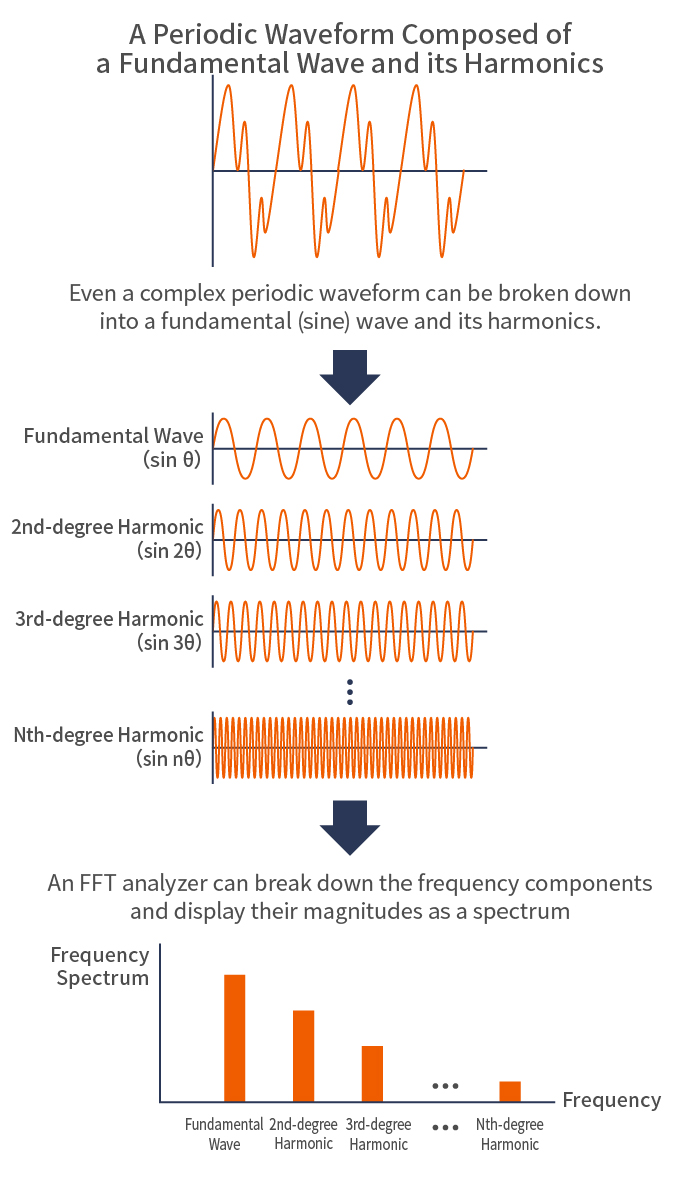
Autointoxication and sound distortion issues in smartphones
In digital audio equipment, the audio signal, which is an analog signal, is AD-converted (analog-to-digital) and recorded as a 0 or 1 digital signal, which is then DA-converted (digital-to-analog) and played back through speakers or headphones. Since the audio signal is transmitted as a numerical (digital) signal, the sound quality should not deteriorate no matter how many times it is played. In practice, however, as it passes through the circuits, harmonics that are not part of the original sound may be introduced as noise components, degrading the sound quality during playback.
While smartphones are often used as digital audio players, they are also wireless communication devices with many built-in antennas. As smartphones grew in functional sophistication, the internal circuitry became extremely dense, leading to problems with electromagnetic noise radiating from audio lines for headphones and speakers. Interference with proximate communication antennas could cause poor reception if no countermeasures were taken.
This type of phenomenon is called autointoxication, in which electronic devices themselves generate electromagnetic noise that adversely affects their functions. However, if noise filters are used as countermeasures, they can degrade sound quality, as later described. Smartphones, which combine advanced digital and wireless communication technologies, face issues that ordinary digital audio devices do not.
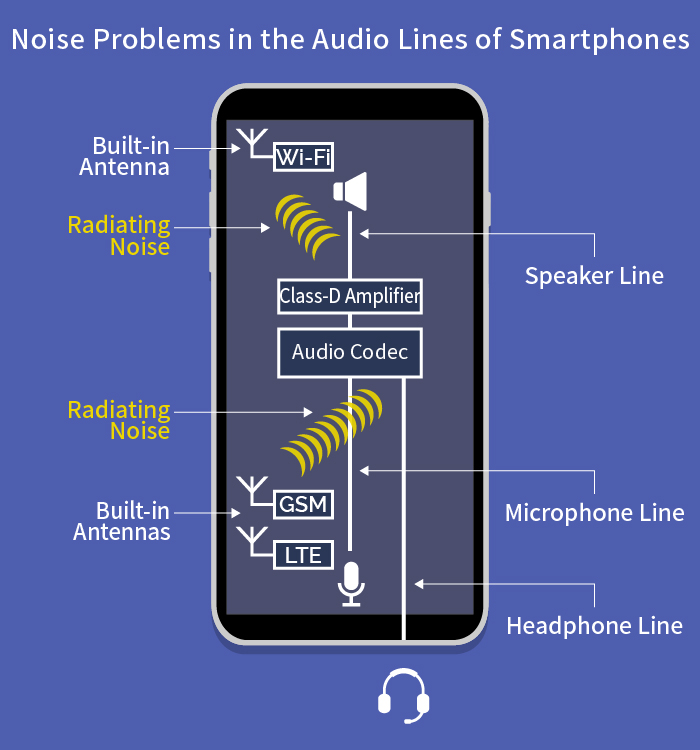
Conventionally, chip beads have been used to suppress noises that radiate from audio signal lines in smartphones. A chip bead is an EMC component with a structure in which a coil is formed inside a ferrite body. In the lower frequency ranges, the reactance of the coil works to reflect and block noise, while in the higher frequency ranges, the resistance of the ferrite absorbs noise and converts it into heat.
For example, in the speaker line of a smartphone, a chip bead containing ferrite with a large resistance component is used because the currents are much larger than in a normal signal line. While this type of chip bead removes noise effectively, it tends to aggravate audio distortion as the output power is raised due to increases in harmonic components. In other words, it used to be difficult to suppress both noise and audio distortion using conventional chip beads made from ferrite material.
Ferrite is a magnetic material with unlimited possibilities; a wide variety of characteristics can be brought out by tweaking material compositions and firing conditions. TDK took full advantage of its expertise in ferrite technology to develop a new ferrite material that maintains noise suppression characteristics while achieving low audio distortion. TDK has commercialized an EMC component ideal for noise suppression in the audio lines of smartphones and other devices. This is the noise suppression filter.
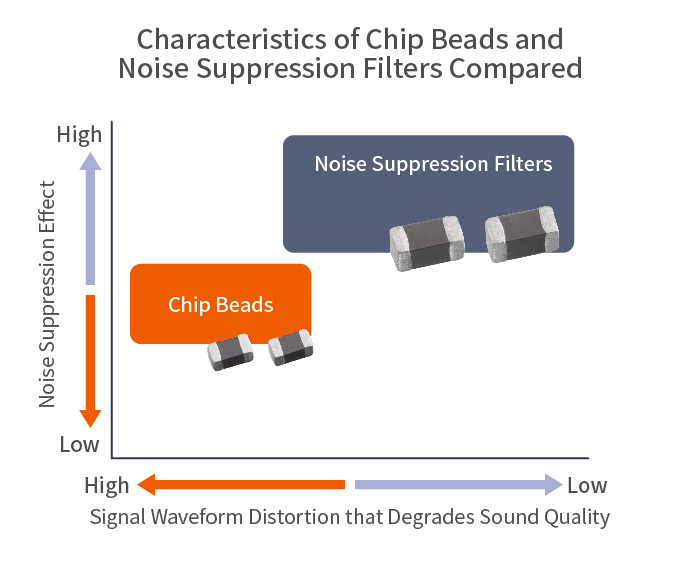
Noise suppression filters that go beyond the limits of chip beads
Conventionally, chip beads have been used to suppress noises that radiate from audio signal lines in smartphones. A chip bead is an EMC component with a structure in which a coil is formed inside a ferrite body. In the lower frequency ranges, the reactance of the coil works to reflect and block noise, while in the higher frequency ranges, the resistance of the ferrite absorbs noise and converts it into heat.
For example, in the speaker line of a smartphone, a chip bead containing ferrite with a large resistance component is used because the currents are much larger than in a normal signal line. While this type of chip bead removes noise effectively, it tends to aggravate audio distortion as the output power is raised due to increases in harmonic components. In other words, it used to be difficult to suppress both noise and audio distortion using conventional chip beads made from ferrite material.
Ferrite is a magnetic material with unlimited possibilities; a wide variety of characteristics can be brought out by tweaking material compositions and firing conditions. TDK took full advantage of its expertise in ferrite technology to develop a new ferrite material that maintains noise suppression characteristics while achieving low audio distortion. TDK has commercialized an EMC component ideal for noise suppression in the audio lines of smartphones and other devices. This is the noise suppression filter.
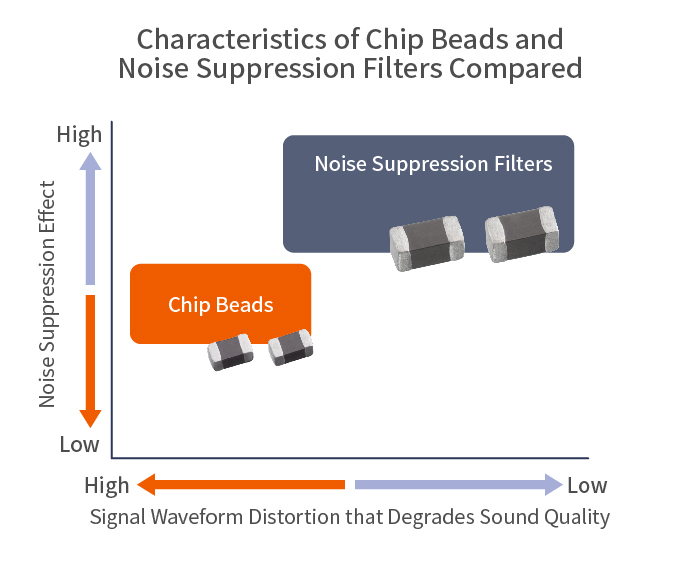
Supporting a pleasant audio experience by eliminating audio distortion
TDK’s noise suppression filters are available as a variety of products optimized for different applications. Products with high attenuation characteristics in the frequency ranges of popular mobile telecommunication bands are highly effective in alleviating the autointoxication problem of reduced reception when placed in the speaker and headphone lines of smartphones.
Products optimized for speaker lines suppress harmonic noises very effectively, helping to ensure high audio quality. The degree of audio distortion in speaker lines is generally expressed as THD+N (Total Harmonic Distortion + Noise). This is a numerical value (in %) that indicates the percentage of harmonic distortion and other noise components to the original signal. The smaller the value, the better the sound quality.
The following graph is a sample comparison between a conventional chip bead and a noise suppression filter when placed in a smartphone’s speaker line. With a chip bead, the THD+N value rises sharply when the output exceeds 200mW. This indicates that the audio distortion is quite conspicuous. When a noise suppression filter is used, even at an output level of 1000mW, the characteristics closely resemble those without the filter. This demonstrates that the placement of noise suppression filters on speaker lines is extremely effective as a countermeasure against audio distortion caused by harmonics.
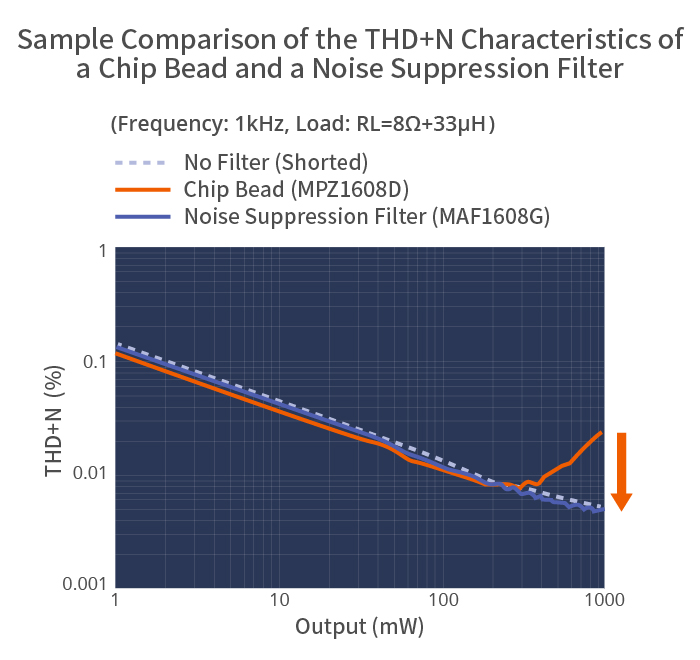
Because we operate mobile devices by hand, electrostatic discharges (ESD) from the human body can cause ICs to malfunction. With smartphones, the headphone jack and other terminals could become entry points of electrostatic discharges. Using a chip varistor (an ESD countermeasure component) and a noise suppression filter together can further improve noise countermeasures for speaker lines and other audio lines.
Smartphones are multifunctional mobile devices that are highly susceptible to noise. Various EMC components from TDK, such as noise suppression filters and chip varistors, help ensure a sound quality that lives up to the expectations of a true audio player.
TDK is a comprehensive electronic components manufacturer leading the world in magnetic technology






